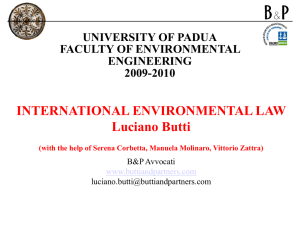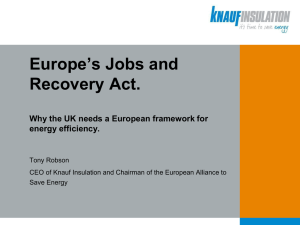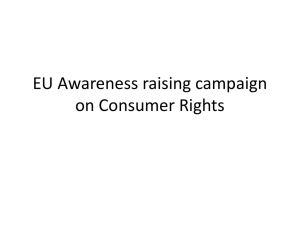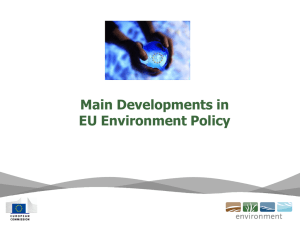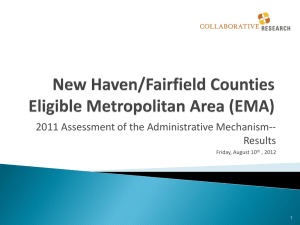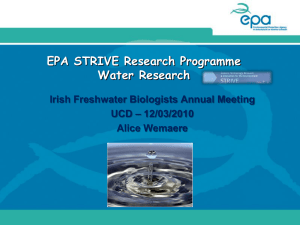Industrial Emissions Directive 4
advertisement
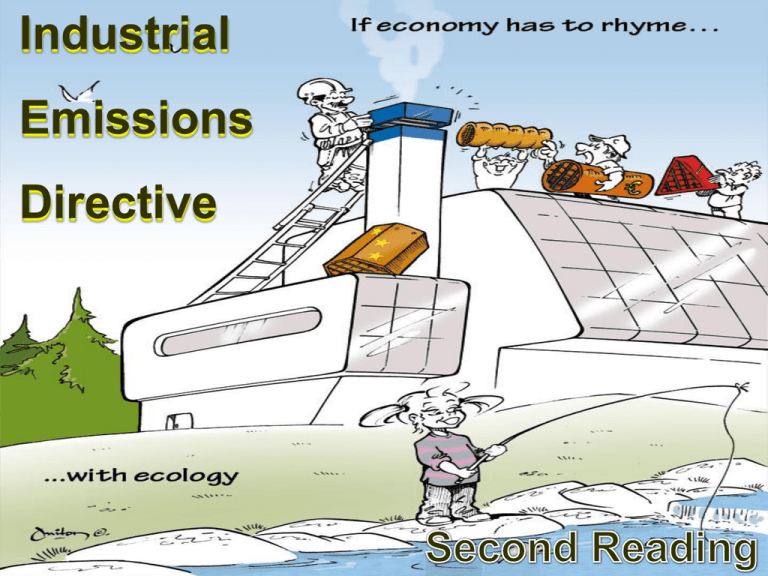
Industrial Emissions Directive 1 Industrial Emissions Directive The European Parliament is discussing the Industrial Emissions Directive as adopted by the Council for the second reading. This Industrial Emissions Directive (IED) aims to protect all sorts of environments from industrial emissions, in a global framework of permits. In an optimized approach, with a view to sustainable environmental protection, the IED should take into account …the different local conditions (climate, topography…) and different technical characteristics of the plants and processes… 2 Industrial Emissions Directive EU history of industrial emissions regulation Some milestones before the IED … The London smog in 1952 resulted in the Clean Air Act; the start of environmental legislation. The EU started legislating 30 years ago : • • • • • 1975: Waste Framework Directive 1978, 1982, 1992: Titanium Dioxide Directives 1988: Large Combustion Plant Directive 1999: Solvent Emissions Directive 2000: Waste Incineration Directive That was a sectoral approach until… 3 Industrial Emissions Directive … the launch of the Integrated Pollution Prevention and Control Directive (IPPC) in 1996 The purpose was to regulate industrial emissions so as to ensure a high level of protection of the environment as a whole emissions to air, water, land generation of wastes use of raw materials energy efficiency noise & vibrations prevention of accidents 4 Industrial Emissions Directive What is the basis of the 1996 IPPC Directive? There are four key strong principles: 1. An integrated and combined approach 2. The use of Best Available Techniques (BAT) , 3. The use of specific solutions adapted to the different environments and industrial plants 4. The requirement of public consultation during permit process. Deadline for implementation was October 2007… 5 Industrial Emissions Directive What are the key elements of the IPPC directive? 1) BREFs - The ‘Seville Process’ produces the BREFs (Best available technique REFerence documents) for each industrial sector. The objective is to inform the relevant decision-makers about the Best Available Technique. They are produced by the “Seville Process” involving stakeholders. 2) The BAT (Best Available Techniques) found in the BREFs are the most effective techniques that are technically and economically available to industry in order to achieve a high general level protection of the environment. 6 Industrial Emissions Directive What are the key elements in the IPPC directive? 3) BATAELs (BAT Associated Emission Levels) are indicative emission levels (found in the BREFs) and relate to the efficiency of the techniques. They are to be used as a reference for establishing specific-site Emission Limit Values. They do not take account of process fluctuations or specific circumstances. 4) ELVs (Emission Limit Values) are safeguards to prevent/minimise environmental impact at the site location. They are not set in the BREF documents. They are legally binding. 7 Industrial Emissions Directive What are the key elements in the IPPC Directive? 5) “ Techniques “ include both the technology used and the way in which the installation is designed built, maintained, quoted and decommissionned 6) “ Available “ techniques: those developed on a sacle which allows implementation in the relevant industrial sector under economically and technically viable conditions, taking into consideration the costs and advantages, whether or not the techniques are used or produced inside the State in question, as long as they are accessible to the operator. 7) “ Best “ means most effective in achieving a high general level of protection for the environment as a whole 8 Industrial Emissions Directive What is the basis of the 1996 IPPC directive? There is one underlying approach: Both the industrial operator and the regulator must take an integrated overall look at the installations and all their environmental impacts, using the European BREF (technical reference document) as a guideline, when taking decisions on how the installations should be operated. Problem: an uneven implementation across States… 9 Industrial Emissions Directive A reshaping process has been launched … 1st reading vote European Parliament 2009 Council of Ministers June 25th 2009 Amendment in ENVI End of March 2010 Vote in ENVI May 2010 2 nd reading July 2010 ENVI (responsible) ALDE: Mr Holger Krahmer (rapporteur) EPP-DE: Mrs Elisabetta Gardini PSE: Mrs Asa Westlund GUE: Mrs Sabine Wils Greens: Mrs Michèle Rivasi & Bas Eickhout ECR: Martin Callanan 10 Industrial Emissions Directive What were the initial ideas of the Commission? A motive to simplify and strengthen drove the IED draft: 1) A more stringent approach with a view to achieving greater consistency in level of implementation. 2) Tighter Europe-wide Emission Limit Values for large combustion plants and for titanium dioxide industries 3) An initial quantitative soil assessment with remediation to the original state when the permit ceases. In fact, some key elements of this IED approach, an over-simplification, may lead to « a one size fits all strategy », which does not always facilitate an adapted environmental protection 4) A combination of 6 existing directives , including the IPPC directive in a single text to simplify environmental permitting. 11 Industrial Emissions Directive What were the initial ideas of the Commission? A motive of better efficiency in the IED draft: * The IED directive aims to disseminate best available technologies for the highest level of emission reductions ** The directive facilitates requirements beyond EU agreed standards ! (art 14.4) *** The directive emphasizes on quantification as trigger for remediation as it is seen as a simple criterion (art 22.2) **** Soil and ground water monitoring always focus on regular surveillance and periodic samplings (art 14.1) In fact, the efficiency aim should be backed up by a more sustainable strategy …which should keep on board environmental, social and economic impacts. 12 Industrial Emissions Directive What is the mechanism of the proposals? emission If you compare the average emissions of a unit with those of other units of the same kind … … you can define Best Available Techniques (BAT) for this process and their related average emission levels (BATAELs) number of units 13 Industrial Emissions Directive What is the mechanism of the proposals? emission To achieve BATAEL on the average, set Emission Limit Values (ELVs) for normal operation accordingly time 14 Industrial Emissions Directive What is our position ? The 1st reading Council common position has improved the IED draft The “One size fits all approach” is not an absolute guarantee to achieve highest environmental protection and consistent implementation of an integrated approach. That is why the provisions allowing useful and justified local adaptation for more sustainable environmental protection must be better secured. 15 Industrial Emissions Directive What is our position ? A sustainable IED needs to be in line with concrete specific needs: • Different emissions behave differently in different locations: => competent authorities must be authorized to grant justified flexibility. (support Art 15.4) •Environmental protection needs a cost benefit analysis on the reductions and side effects : =>going beyond Best Available Techniques by competent authorities must be fully justified (amend art 14.4); => remediation measures must be based on technical and economic feasibility (amend art 22.3) 16 Industrial Emissions Directive What is our position ? A pragmatic IED needs to be in line with concrete specific needs: • The BATAEL must be based on representative datasets from all over the EU (support Art 13) •Combustion installations on chemical sites have a specific character as they burn specific fuels: New Emission Limit Values (ELV) should be adapted to chemical plants burning off gases and residues (support Art 30-9). 17 Industrial Emissions Directive What is our position ? A sustainable IED should build on the experience of stakeholders • The opinion of the relevant stakeholders must be taken into account when adopting decisions on BAT: => the conclusions of the Seville process must be safeguarded during the comitology. (support Art 13.4) => Need for a stakeholder consultation when setting Emissions Limit Values in case of a missing BREF (amend Art 14.6) 18 Industrial Emissions Directive What is our position ? A sustainable IED needs to give certainty to investors • Investment cycles executed and planned with a view to compliance with the LCP Directive must be recognised: => Transitional national plans must help progressively planned compliance with ELVs (support Art 32) • New investors on existing sites cannot take unforseeable legal and financial risks: => a risk-based approach must be promoted to analyse the potential contamination of soil (amend Art 22.2) 19 Industrial Emissions Directive Sustainable environmental protection would be ensured with: In short - Permit conditions that would take account of site-specific circumstances and considering technical & economic feasibility -European requirements that would be set only where appropriate. - BREFs and BATAELs that would be used as a basis for setting ELVs if supported by the appropriate experience of stakeholders - proportionate and risk-based soil & ground water protection measures 20 Industrial Emissions Directive A justified level of flexibility can take on board environmental and economic considerations…… allowing society and environment to prosper in a sustainable way for the benefit of all 21

